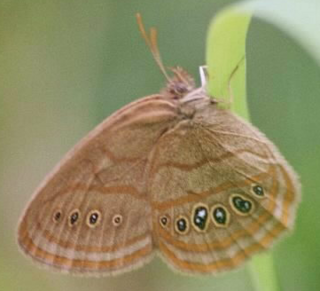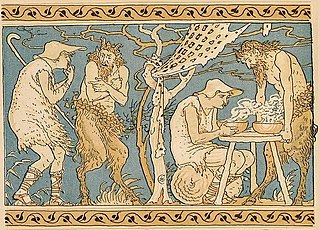
In Greek mythology, a satyr, also known as a silenus or silenos, is a male nature spirit with ears and a tail resembling those of a horse, as well as a permanent, exaggerated erection. Early artistic representations sometimes include horse-like legs, but, by the sixth century BC, they were more often represented with human legs. Comically hideous, they have mane-like hair, bestial faces, and snub noses and are always shown naked. Satyrs were characterized by their ribaldry and were known as lovers of wine, music, dancing, and women. They were companions of the god Dionysus and were believed to inhabit remote locales, such as woodlands, mountains, and pastures. They often attempted to seduce or rape nymphs and mortal women alike, usually with little success. They are sometimes shown masturbating or engaging in bestiality.

In Greek mythology, Silenus was a companion and tutor to the wine god Dionysus. He is typically older than the satyrs of the Dionysian retinue (thiasos), and sometimes considerably older, in which case he may be referred to as a Papposilenus. The plural sileni refers to the mythological figure as a type that is sometimes thought to be differentiated from a satyr by having the attributes of a horse rather than a goat, though usage of the two words is not consistent enough to permit a sharp distinction. Silenus presides over other daemones and is related to musical creativity, prophetic ecstasy, drunken joy, drunken dances and gestures.

The faun is a half-human and half-goat mythological creature appearing in Greek and Roman mythology.

Satyricon is a Norwegian black metal band formed in Oslo in 1991. Satyr and Frost have been the band's core members since 1993. The band's first three albums typify the Norwegian black metal style. Since its fourth album in 1999, the band has strayed from this style and included elements of traditional heavy metal in their sound. Satyricon was the first Norwegian black metal band to join a multi-national record label (EMI).

The satyr play is a form of Attic theatre performance related to both comedy and tragedy. It preserves theatrical elements of dialogue, actors speaking verse, a chorus that dances and sings, masks and costumes. Its relationship to tragedy is strong; satyr plays were written by tragedians, and satyr plays were performed in the Dionysian festival following the performance of a group of three tragedies. The satyr play’s mythological-heroic stories and the style of language are similar to that of the tragedies. Its connection with comedy is also significant – it has similar plots, titles, themes, characters, and happy endings. The remarkable feature of the satyr play is the chorus of satyrs, with their costumes that focus on the phallus, and with their language, which uses wordplay, sexual innuendos, references to breasts, farting, erections, and other references that do not occur in tragedy. As Mark Griffith points out, the satyr play was "not merely a deeply traditional Dionysiac ritual, but also generally accepted as the most appropriate and satisfying conclusion to the city’s most complex and prestigious cultural event of the year."

The Saint Francis' satyr is an endangered butterfly subspecies found only in the US state of North Carolina. First discovered in 1983, it was first described by David K. Parshall and Thomas W. Kral in 1989 and listed as a federally endangered species by the US Fish and Wildlife Service in 1994. It is a subspecies of N. mitchellii and is restricted to a single metapopulation on Fort Bragg military base in Hoke and Cumberland counties. The other subspecies, Mitchell's satyr, is also federally endangered.

The satyr tragopan also known as the crimson horned pheasant, is a pheasant found in the Himalayan reaches of India, Tibet, Nepal and Bhutan. They reside in moist oak and rhododendron forests with dense undergrowth and bamboo clumps. They range from 2400 to 4200 meters in summer and 1800 meters in winter. The male is about 70 cm long.

Cyclops is an ancient Greek satyr play by Euripides, based closely on an episode from the Odyssey. It would have been the fourth part of a tetralogy presented by Euripides in a dramatic festival in 5th Century BC Athens. The date of its composition is unknown, but it was probably written late in Euripides' career. It is the only complete satyr play extant.

Venus and Cupid with a Satyr is a painting by the Italian High Renaissance artist Antonio da Correggio. It is now in the Musée du Louvre in Paris.

USS Satyr (ARL-23) was one of 39 Achelous-class landing craft repair ships built for the United States Navy during World War II. Named for the Satyr, she was the only US Naval vessel to bear the name.

The Painter of Nicosia Olpe was an ancient Greek vase painter, who was producing work around 575 BC to 475 BC, and these dates are concluded from the vases that were found and attributed to the specific painter. All of the pieces are black-figure, and this can also be determined by the dates. The majority of vases that he painted were larger pieces; this is not something that he had control over, but he did have control over the scenes on the vases.

The Satyr and the Traveller is one of Aesop's Fables and is numbered 35 in the Perry Index. The popular idiom 'to blow hot and cold' is associated with it and the fable is read as a warning against duplicity.

Neominois ridingsii, or Ridings' satyr, is a species of butterfly in the family Nymphalidae. It is found from southern Alberta, Saskatchewan and Manitoba south to the Guadalupe and Catron counties of New Mexico, and west to the central Sierra Nevada of California and central Oregon. The habitat consists of short-grass prairie, intermountain areas and grasslands with some areas of bare soil.
Neominois carmen, the Joboni satyr, is a species of butterfly in the family Nymphalidae. It is found in north-eastern Mexico, at least from the Maderas del Carmen in north-western Coahuila, to the area west of Linares in southern Nuevo León. The habitat consists of open areas at the beginning of pine-oak woodland.

Jupiter and Antiope is an oil painting by the French artist Antoine Watteau. It is also known as the Satyr and the Sleeping Nymph and was probably painted between 1714 and 1719. Intended to be placed over a doorway, today it hangs in the Musée du Louvre in Paris.

Two Satyrs is a 1618-1619 oil on canvas painting by Peter Paul Rubens. It measures 76 by 66 cm and is now in the Alte Pinakothek in Munich.

The Pardo Venus is a painting by the Venetian artist Titian, completed in 1551 and now in the Louvre Museum. It is also known as Jupiter and Antiope, since it seems to show the story of Jupiter and Antiope from Book VI of the Metamorphoses. It is Titian's largest mythological painting, and was the first major mythological painting produced by the artist for Philip II of Spain. It was long kept in the Royal Palace of El Pardo near Madrid, hence its usual name; whether Venus is actually represented is uncertain. It later belonged to the English and French royal collections.
In Greek mythology, Cyllene, also spelled Kyllene, is the Naiad or Oread nymph and personification of Mount Cyllene in Arcadia, the region in Greece where the god Hermes was born and brought up.















